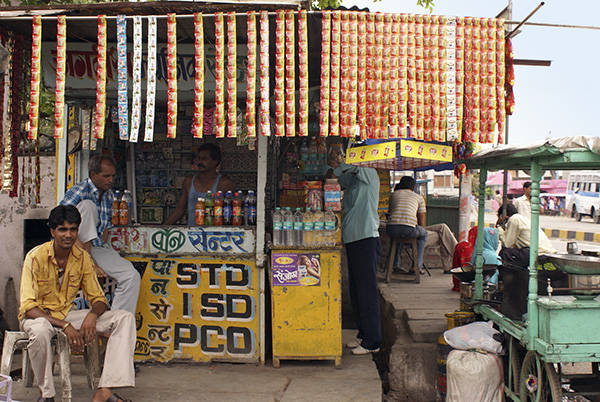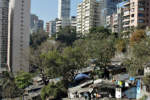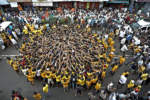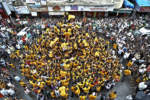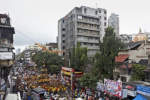Today in most cities around the world there exist several forms of urbanism that coexists on the same space. These varied concepts of urbanism (whether Everyday Urbanism, New Urbanism, Post-Urbanism or the several forms of Indigenous Urbanism) actually collapse into a simultaneous (often kaleidoscopic) manifestation of these varied conditions. This collapse of varying conceptions of urbanism into a singular but multifaceted entity takes on a bizarre form in the cities of Latin America, Asia and Africa where disparate levels of economic development complicate the already schizophrenic landscape of contemporary urbanism. In these urban conditions, the physical manifestation of the city is reversed and here, the static city or formal city is most often situated in the temporal landscape of the kinetic city or informal city.
It is in these urban landscapes (of Latin America, Asia and Africa), that the informal or kinetic city can be seen as the symbolic image and metaphor for the physical state of the contemporary city. In fact, it is from the kinetic city that these cities derive their image today. The processions, festivals, street vendors and dwellers, all result in an ever transforming streetscape – a city in constant motion where it’s very physical fabric is characterized by this kinetic quality. Furthermore, the kinetic city is incomprehensible as a two-dimensional entity and is instead perceived as a city in motion – a three-dimensional construct of incremental development. It is temporary in nature and often built with recycled material: plastic sheets, scrap metal, canvas and waste wood. It constantly modifies and reinvents itself.
In contrast, the static city, is built of more permanent material such as concrete, steel and brick, and is comprehended as a two-dimensional entity on conventional city maps and is monumental in its presence. Architecture is clearly the spectacle of the static city. And while the static city depends on architecture for its representation, it is no longer the single image by which the city is read. On the other hand, the kinetic city is not perceived through its architecture, but by spaces, which hold associative values and support lives. Patterns of occupation determine its form and perception. It is an indigenous urbanism that has its particular ‘local’ logic. It is not necessarily only the city of the poor, as most images and discussions of the informal city might suggest; rather it is a temporal articulation and occupation of space which not only creates a richer sensibility of spatial occupation, but also suggests how spatial limits are expanded to include formally unimagined uses in dense urban conditions.
The informal or kinetic city carries local wisdom into the contemporary world without fear of the modern, while the static city aspires to erase the local and re-codify it in a written formal order. The issue of housing (slums, favellas etc) most vividly demonstrates the re-ordering process of the kinetic city by the static city. Flow, instability and indeterminacy are basic to the kinetic city. Regular demolitions exacerbate the tenuous occupation of land by the inhabitants of the informal city. The demolitions inhibit any investment the occupants might make in their physical living conditions. Thus the kinetic city is a fluid and dynamic city that is mobile and temporal (often as a strategy to defeat eviction) and leaves no ruins. It constantly recycles its resources leveraging great effect and presence with very little means.
Clearly the static and kinetic cities go beyond their obvious differences to establish a much richer relationship both spatially and metaphorically than their physical manifestations would suggest. Here affinity and rejection are simultaneously played out and are in a state of equilibrium maintained by a seemingly irresolvable tension. The informal economy of the city vividly illustrates the collapsed and intertwined existence of the static and kinetic cities.
In fact, the kinetic city presents a compelling vision that potentially allows us to better understand the blurred lines of contemporary urbanism in Latin America, Asia or Africa and the changing roles of people and spaces in urban society. The increasing concentrations of global flows in these contexts have exacerbated the inequalities and spatial divisions of social classes. In this context, an architecture or urbanism of equality in an increasingly inequitable economic condition requires looking deeper to find a wide range of places to mark and commemorate the cultures of those excluded from the spaces of global flows. These don’t necessarily lie in the formal production of architecture, but often challenge it. Here the idea of a city is an elastic urban condition, not a grand vision, but a ‘grand adjustment’.
Thus it is critical that any discussion on the informal city takes as its starting point a broadening of the definition of the “informal” to go beyond the normal understanding of this phenomenon as the city of the poor and marginalized! That’s is expand the original definition where the informal stems from the essential conditions of correcting or compensating for the mal distribution of resources in an urban condition.
These are resources that extend all the way from access to social and physical infrastructure to city culture in the broadest sense. But, the limits of informal urbanism are hard to define or outline clearly. It seems to be a notion that extends beyond the mere provision of the non-regulated or non-official or governmental system. Instead it seems to be an idea that is about the tactics and innovation that the urban poor and marginalized have to offer. That is the ability to absorb, recycle, provide services, establish networks, celebrate, play and essentially extend the margins of the urban system to new levels of robustness. In short, Informal urbanism or the kinetic city is about invention within strong constraints and with indigenous resources as well as turning odds into a survival strategy – often a sustainable strategy! The “kinetic” quality of informal urbanism does not allow most governmental or formal systems to keep pace with or respond meaningfully to the spontaneity inherent in the nature of informal action. This creates a great gulf disallowing accurate identification or analysis of the condition, resulting in mistrust and opening up question of citizenship and legality. Ironically, often it is the informal city that is the site of meaningful production in the city and as Saskia Sassen has pointed out the informal city is often the strategic component of advanced urban economies! Thus it is critical for us to re-look at this urban condition from the perspective of economy, legality, activism, governance and collaborations. In addition to this, questions of representation or how you map and register the temporal, transient and flexible become evident as lacunas in the debate about informality. And most importantly the question of simultaneity and co-existence emerges as one that will need an increasing attention from the perspective of new challenges in the design or redesign of cities: can the spatial configuration for how this simultaneity occurs actually be formally imagined? The kinetic city obviously cannot be seen as a design tool but rather a demand that conceptions of urbanism create and facilitate environments that are versatile and flexible, robust and ambiguous enough to allow this kinetic quality of the city to flourish. Perhaps the kinetic city might be the tactical approach to take when dealing with the urbanism of the temporary, or of high densities and Intensities?
Re thinking the informal city, will hopefully take the discussion on Informal urbanism beyond the humanitarian dimensions (of empathizing with the city of the poor) to look at its value as the crucible for innovation. Adaptability, flexibility, resistance and several other such aspects that would inform the broader discourse on Urbanism in general are obvious pointers for design. However, in order to make a more substantial connection to understand and inform contemporary urbanism, it is critical that the binaries that have come to define the terms for this debate (the rich and poor, the formal and informal, the center and periphery the third and first worlds) be dissolved. Instead, the discussion should be positioned in different terms such as questions of the hybrid, simultaneity, notions of coexistence and other ways of framing the issue. That is re-frame the debate about the informal that would sustain this innovative form of urbanism and its seamless integration into the discussion of contemporary urbanism. It is with this shift that the informal city would perhaps be seen not as a condition that needs to be re-made but rather as a contagious phenomenon that actually remakes and humanizes cities.
Re-thinking the informal city
area 128
| informal community


